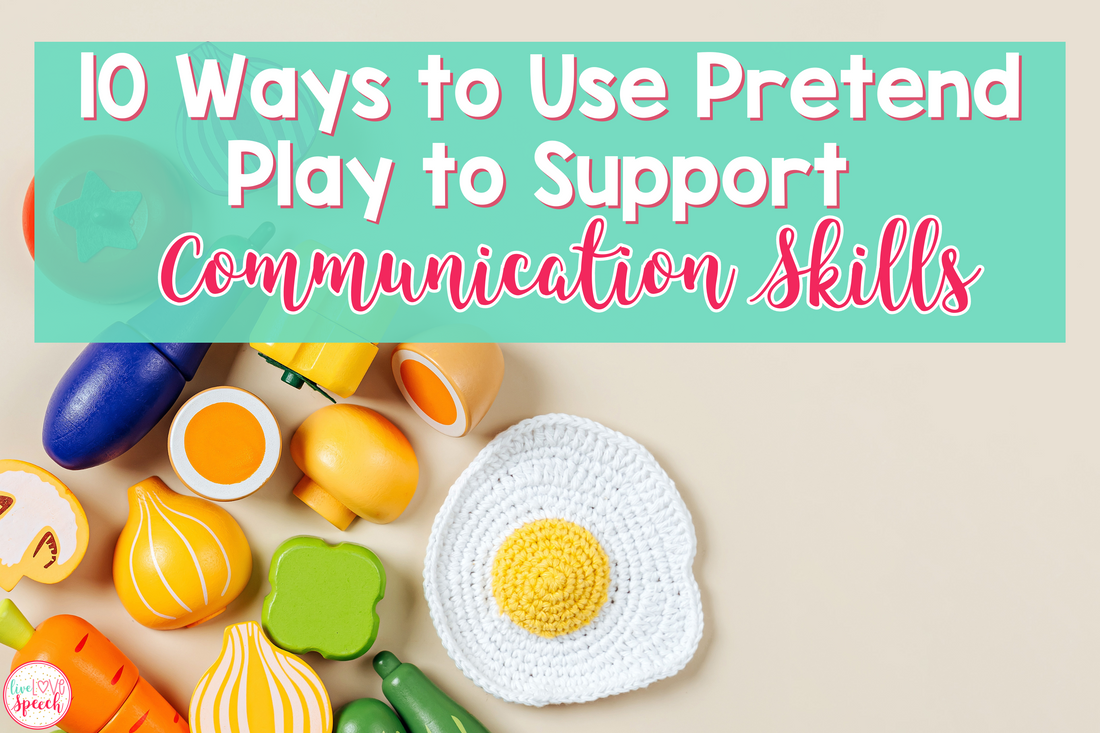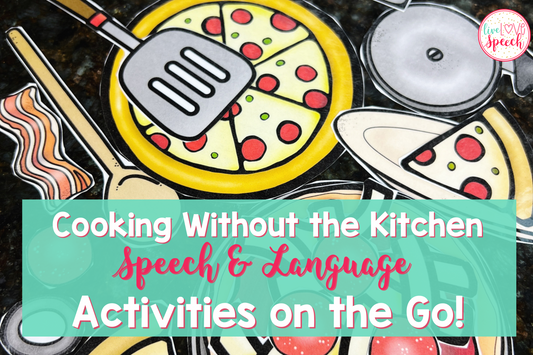
Isn't it just the best to see our kids or students immersed in pretend play, whether they're playing shopkeeper, having a tea party with their stuffed animals, or savoring imaginary bites in their make-believe restaurant? Thinking back, do you have any favorite pretend play moments with your kids or students? My personal favorite is having them engage with me as we play make-believe restaurant (where I order all the things). But think about it – what if you could transform this into a learning experience that helps them boost communication skills?
As many of you know, I'm a strong advocate for enhancing communication through cooking, as evident in my previous post here where I covered ways to boost communication with your kids in the kitchen. Taking things up a notch, I aim to explore the world of food and cooking once again, but this time with a twist – pretend play! In this blog post, we will explore 10 ways not only to engage in pretend play with food but also to support and enhance communication skills.
HOW TO BOOST COMMUNICATION SKILLS USING PRETEND PLAY

1. Role Play and Description:
Encourage kids to step into the shoes of a chef or the proud owner of their very own imaginary restaurant. It could be their favorite spot in town or a creation they dream about. Picture them in charge, confidently describing their favorite meals they cook. Maybe it's pizza or pasta—whatever it is, have them go into details about what is on each item. "Is their pizza covered in mushrooms, or is it a very cheesy pepperoni?" But don't stop there; guide them through the ingredients used, prompting them to share what each meal needs. Get them to explore the process, from the first step to the last, encouraging descriptions that bring their dishes to life. This isn't just about expanding their vocabulary but also storytelling, which makes learning a whole lot more fun.
2. Menu Creation:
Next, it's time to have them create a menu for their pretend restaurant or café. Let's think of names for their dishes, whether it's "Cheesy Smiley Face Pizza" or "Rainbow Noodle Delight." Have kids be in charge of their food. After they come up with their names, have them write the descriptions. What is included in these meals? Are the pizza smiles made of gooey, delicious cheese, and does the rainbow pasta include a tasty tomato sauce? This can also be done with pictures; have your kids draw pictures of their favorite creation. This creative drawing exercise not only adds a playful touch to their pretend play but also becomes a canvas for boosting their artistic expression. This activity enhances both writing and creativity.

3. Sequencing:
Now, let's practice sequence and order in our pretend food fun! Engage your kiddos in practicing sequencing skills by guiding them through the step-by-step process of creating their imaginary dishes. Prompt them with questions like, "What do we need to make a pasta dish?" Encourage them to think logically and list the ingredients and steps in the right order. Perhaps it starts with choosing the type of pasta, followed by boiling it to perfection, and finishing with the delicious sauce.
Extend this playful learning experience by diving into the world of pretend pizza. Ask them, "Tell me the steps to bake a pretend pizza." Let their imagination soar as they map out the journey from rolling out the dough to generously sprinkling on the pretend toppings. This sequencing exercise not only sharpens their organizational skills but also serves as a delightful recipe for boosting their ability to follow steps in a logical order.
4. Categorization:
Encourage your little ones to learn categorization by sorting pretend food items into groups like fruits, vegetables, desserts, and more. This simple yet engaging activity serves as a fantastic way for kids to enhance their organizational and classification skills.
As they create their own make-believe grocery store or restaurant pantry, ask them to group items together based on common characteristics. Why do tomatoes belong in the same category as apples, while cupcakes find their place with cookies? This exercise not only helps their creativity but also lays the foundation for essential cognitive skills.
Categorization helps children understand the relationships between different objects and how they can be grouped based on shared features. This skill is crucial as it lays the groundwork for more advanced cognitive abilities in the future.

5. Following Directions:
Engage your little ones by giving them verbal instructions to set up a pretend food picnic or prepare a make-believe meal. For instance, you might say, "Put the apple on the plate, then bring the cup and place it next to the plate." This interactive activity not only sparks their imagination but also becomes an exercise in listening and following directions.
As they move and arrange their imaginary set-up based on your instructions, they not only learn about spatial relationships but also practice crucial skills in attentive listening and sequential processing.
Learning to follow directions is an essential skill that goes beyond the pretend play kitchen. It lays the groundwork for effective communication and understanding instructions in various settings, from the classroom to everyday tasks.
6. Describing Attributes:
Have your kids explore the sensory delights of pretend food! Encourage them to describe the attributes of their imaginary culinary creations, such as taste, texture, color, and size. For example, they might say, "The pretend orange is round, orange, and juicy." This activity not only stimulates their creativity but also provides a playful exploration of descriptive language.
By doing this, your kids are not just engaging in pretend taste-tests and texture explorations, but they are also building a rich vocabulary that allows them to articulate the qualities of different objects. Whether it's the crunchiness of a make-believe apple or the sweetness of an imaginary cupcake, each description adds to their growing language skills.

7. Imaginative Play:
Encourage your kids to engage in imaginative play scenarios using the pretend food. Picture a tea party where all their favorite teddy bears are there, or perhaps a grocery shopping adventure where every item on the list is a must-have find. You can even go on a cooking journey by cooking up a storm for an imaginary picnic in the backyard. This playful activity not only fosters creativity but also nurtures essential social skills.
As they work their way through these make-believe scenarios, your kids aren't just playing with pretend ingredients; they're crafting stories and building a world where their imagination knows no bounds. Each tea party sip and picnic preparation become a chapter in the book of their creativity, allowing them to express themselves and develop crucial social skills in the process.
8. Social Language Practice
Introduce your kids into role-play by having them in different social interactions using their pretend food. They can take on the roles of customers ordering dishes at a make-believe restaurant, politely asking for assistance when needed, or generously sharing their imaginary treats with others. This interactive activity plays a crucial role in developing essential social communication skills.
As they engage in these pretend scenarios, your kids are not just playing restaurant or grocery store; they are stepping into the shoes of different characters, navigating the give-and-take of social interactions. Each interaction becomes a steppingstone in their social development, fostering skills such as effective communication, cooperation, and understanding social cues. Whether it's a friendly exchange at the make-believe checkout counter or a polite request for assistance, these role-playing scenarios offer a safe space for your kids to practice and refine their social language skills.

9. Storytelling:
Now, let's make our pretend kitchen time even more exciting with a bit of storytelling! Encourage your little ones to use their pretend food items as inspiration for crafting fun stories. Have them come up with characters and adventures related to their favorite make-believe dishes. For instance, Lily, a young chef, crafted a magical dish named "Starlight Stew." This creative activity not only sparks their imagination but also turns regular playtime into an engaging storytelling experience.
10. Problem Solving:
Guide your kids through creative problem-solving scenarios using their imaginative kitchen setup. For instance, pose challenges like, "How can we make sure everyone gets a taste of the pretend ice cream with only two cones?" or "Imagine we have only one ingredient, pretend cheese. What inventive dish can we create for our make-believe dinner party?" You can even introduce scenarios like, "You're hosting a pretend picnic, but how can we transport our delicious imaginary sandwiches safely without them getting squished?"
As your kids tackle these imaginative challenges, they aren't just playing with pretend food; they're transforming into master problem solvers.
Play Food & Kitchen Visual
Take your pretend play experience up a notch with the addition of my evidence-based resource, Visuals for Toys! This set not only includes visuals for 16 different toys but also incorporates play food and kitchen visuals within these 16 items. Aligning seamlessly with the interactive and imaginative activities of pretend play, it serves as a comprehensive tool. Moreover, it targets various skill areas such as Verbs, Adjectives, Basic concepts, CV, VC, CVC, Stops, Consonant Clusters, Fricatives & Affricates, Liquids, and Questions, enhancing communication skills through engaging play. Grab your Visuals here and extend your pretend play further!
SAVE THIS POST FOR LATER
Don't forget to save this post on Pinterest so you'll be all set when you're ready to add some new, kid-friendly cooking tips to your collection!






